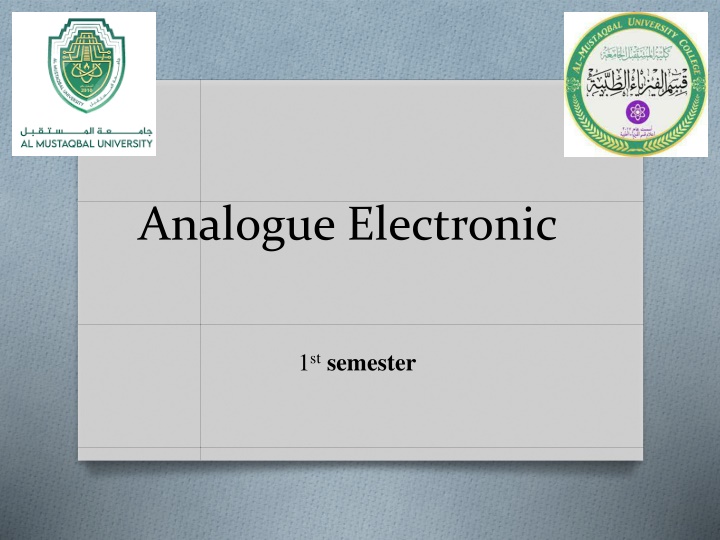
Analogue Electronic - Transistor Circuit Analysis and Characteristics
Explore the basics of transistor circuit analysis, characteristics, and parameters in analogue electronic circuits. Learn about transistor currents, voltage drops, DC biasing, and more. Dive into examples and illustrations to enhance your understanding.
Download Presentation

Please find below an Image/Link to download the presentation.
The content on the website is provided AS IS for your information and personal use only. It may not be sold, licensed, or shared on other websites without obtaining consent from the author. If you encounter any issues during the download, it is possible that the publisher has removed the file from their server.
You are allowed to download the files provided on this website for personal or commercial use, subject to the condition that they are used lawfully. All files are the property of their respective owners.
The content on the website is provided AS IS for your information and personal use only. It may not be sold, licensed, or shared on other websites without obtaining consent from the author.
E N D
Presentation Transcript
Analogue Electronic 1stsemester
Chapter 4 Transistor Lecture 9 2
Transistor Currents The conventional current flows toward the arrow on the emitter terminal. The emitter current (IE) is the sum of the collector current (IC) and the small base current (IB). That is, IE = IC + IB IB is very small compared to IE or IC. The capital-letter subscripts indicate DC values. The voltage drop between the base and emitter is VBE, whereas the voltage drop between the collector and base is called VCB. Figure: Transistor currents. 3
BJT Characteristics and Parameters Two important parameters, DC (DC current gain) and DC are used to analyze a BJT circuit. When a transistor is connected to DC bias voltages, as shown in Figure below for bothnpn and pnp types, VBB forward-biases the base-emitter junction, and VCC reverse-biases the base-collector junction. Figures of transistor DC bias circuits. The collector current is directly proportional to the base current. IC IB The DC of a transistor is the ratio of the DC collector current (IC) to the DCbase current (IB). This equation explains the amplification of current. The ratio of the DC collector current (IC) to the DC emitter current (IE) is the ( DC). is always less than 1 4
Example Determine the dc current gain DC and the emitter current IE for a transistor where IB=50 A and IC= 3.65 mA. Solution 5
BJT Circuit Analysis Consider the basic transistor bias circuit configuration in the Figure below. Three transistor DC currents and three DC voltages can be identified. IB: DC base current IE: DC emitter current IC: DC collector current VBE: DC voltage across the base-emitter junction VCE: DC voltage across collector-emitter junction VCB: DC voltage across collector-base junction Figure 4: Transistor currents and voltages. 6
When the base-emitter junction is forward-biased, It is like a forward-biased diode and has a forward voltage drop of VBE 0.7 V The voltage at the collector concerning the grounded emitter is VCE=VCC ICRC (ICRC=VRC ) The current across IB is The voltage across the reverse-biased collector-base junction is VCB=VCE VBE 7
Example: Determine IB, IC, IE, VBE, VCE, and VCB in the circuit of the following Figure. The transistor has a DC = 150. Solution: VBE 0.7 V, Calculate the base, collector, and emitter currents as follows: Since the collector is at a higher voltage than the base, the CB junction is reverse-biased. 8
Collector Characteristic Curves The collector characteristic curves show three modes of operation of the transistor. The collector current IC variation varies with the VCE for a specified value of base current IB. Assume that VBB is set to produce a certain value of IB, VCC is zero, and VCE is zero. As VCE is increased, IC increases until IB becomes constant. When both BE, and BC junctions are forward biased, and the transistor is in the saturation region. Figure : Collector characteristic curves. 9
In saturation, an increase in base current does not affect the collector current, and the relation IC= DCIB is no longer valid. VCC VCE (SAT) RC The transistor current is maximum, and the voltage across the collector is minimum for a given load. IC (SAT) = Figure : Base-emitter and base-collector junctions are forward-biased. 10
When VCE is increased further and exceeds 0.7 V, the base-collector junction becomes reverse-biased, and the transistor goes into its operation's active, or linear, region. IC levels off and remains essentially constant for a given value of IB as VCE continues to increase. The value of IC is determined only by the relationship expressed as IC= DCIB. A family of collector characteristic curves is produced when IC versus VCE is plotted for several values of IB, as illustrated in Figure below. It can be read from the curves. The value of DC is nearly the same wherever it is read in the active region. In a BJT, the cutoff is the condition of no base current (IB=0), which results in only an extremely small leakage current (ICEO) in the collector circuit. The subscript CEO represents collector to emitter with the base open. For practical work, this current is assumed to be zero. In cutoff, neither the BE junction nor the BC junction is forward-biased. Figure: Cutoff: Base-emitter and base-collector junctions are reverse-biased. 11
Example: Determine whether or not the transistor in the following figure is in saturation. Assume VCE(sat)= 0.2V. Solution: This shows that with the specified DC, this base current can produce an IC greater than IC(sat). Therefore, the transistor is saturated. 12
The BJT as a Switch A BJT can be used as a switching device in logic circuits to turn on or off the current to a load. As a switch, the transistor is normally in either cutoff (load is OFF) or saturation (load is ON). Figure: Switching action of an ideal transistor. 13















